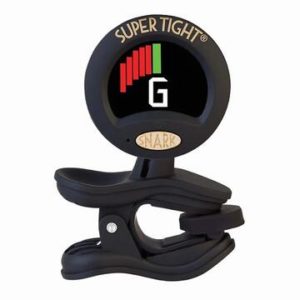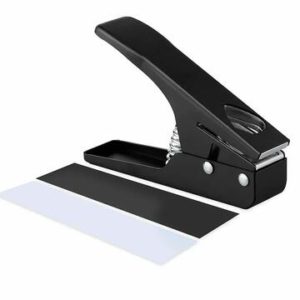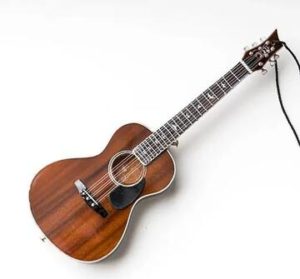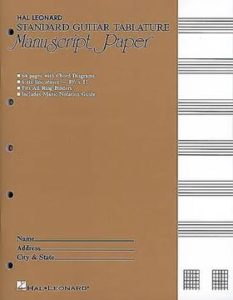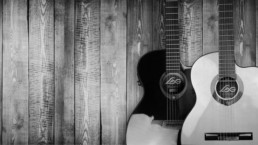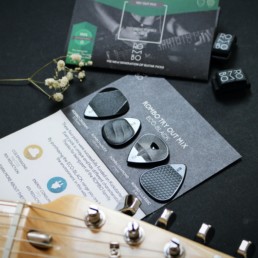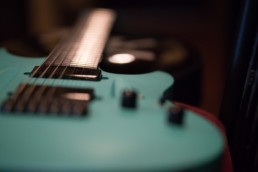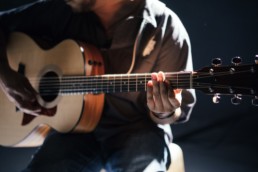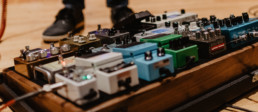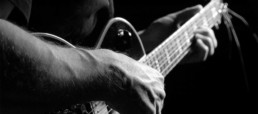10 Guitar Lover Gift Ideas for Under $50
JP BLOG
Share this
If you have a guitar player in your life, and you’re wondering what to get them, you’re in luck because guitar players love new gear and accessories to go along with their instrument. Below you’ll find 10 gifts under $50 that the guitar player in your life is sure to love.
Suction Cup Smartphone Holder for Acoustic, Electric, or Classical Guitar
Price: $22.99 at Reverb
Smartphone technology has revolutionized so many aspects of our lives, from communication to productivity. Guitar playing is no exception. With apps for recording, tuning a guitar, or simply displaying a guitar player’s favorite guitar tabs, it can be a hassle to try to position the phone just right to be able to see the screen. With this super convenient smartphone holder that attaches to the face of the guitar with a suction cup, looking at the phone screen while playing becomes a breeze.
Snark ST-8 Super Tight Clip-On Chromatic Tuner
Price: $13.99 at Reverb
During a performance, it can be really frustrating to discover the guitar is out of tune. It can also be a real challenge to tune a guitar in a loud environment. But with this clip-on tuner, a guitar player can quickly, easily, and accurately tune their guitar by just playing the strings, letting the tuner sense the vibrations, and tightening or loosening the string according to the tuner’s instructions.
Dunlop Microphone Stand Pick Holder
Price: $3.49 at Reverb
It’s pretty common to drop the pick in the midst of a performance, but this mic stand pick holder makes replacing the pick easy and convenient. With the ability to hold up to 6 picks, the guitar player in your life will thank you for solving this common frustration.
HQMaster Guitar Pick Punch Pick Maker
Price: $25.94 at Reverb
When a guitar player runs out of guitar picks, there’s a more convenient solution than having to drop everything and drive to the music store to buy more. With this guitar pick puncher, any piece of thin plastic can be turned into a guitar pick in a flash.
Mar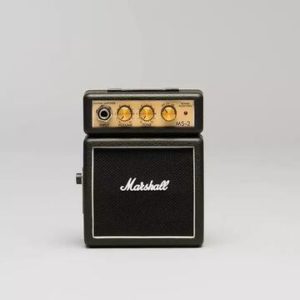 shall MS-2 Micro Stack Amp
shall MS-2 Micro Stack Amp
Price: $49.99 at Reverb
For the electric guitar player in your life, this small practice amp makes playing on the go fun and convenient. Modeled after one of Marshall’s more popular guitar amps, this amp has both clean and overdrive tone capabilities.
Martin Suede Acoustic Guitar Strap
Price: $32 at Reverb
For the acoustic guitar player in your life, this guitar strap is solidly constructed, and Martin is one of the top brands in the acoustic guitar market. The strap is made from genuine suede leather and features an embossed C. F. Martin logo.
2020 Parlor Acoustic Collectible Holiday Ornament
Price: $24.99 at Reverb
Modeled after Paul Reed Smith’s popular Parlor acoustic guitar and handmade from solid wood, this ornament will make an excellent addition to any guitar player’s holiday tree or even to display all year round. The ornament is intricately designed with all the details you’d expect from this top-of-the-line guitar maker.
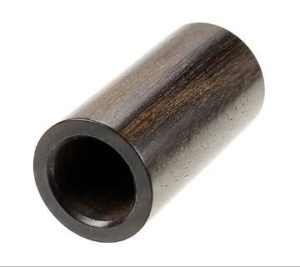
Taylor Crelicam Ebony Guitar Slide
Price: $19.99 at Reverb
This ebony guitar slide from Taylor Guitars is a warm-sounding alternative to glass and metal guitar slides. This is a great gift for any guitar player that enjoys more bluesy or country steel guitar styles.
Guitar Tablature Manuscript Paper
Price: $6.89 at Reverb
For the guitar player in your life that enjoys creating original guitar music, this is a perfect gift that will be extremely useful. With both music staffs, guitar tab lines, and chord chart diagrams, a guitar player can record original ideas on paper to remember later or transcribe for other players.
Dunlop Guitar Pick Variety Pack
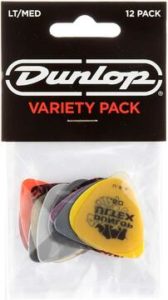
Price: $3.79 at Amazon
Guitar picks are a necessity for almost any guitar player, but the choice of guitar pick is unique to each player. With a variety pack, you can’t go wrong because it will give the guitar player in your life the opportunity to try out a few different picks to see what they like best.
Ready for some guitar love? Drop a hint for someone to treat you with a JamPlay gift card or treat yourself.
Related Posts
Comments
5 Questions to Ask Before Buying a New Guitar This Holiday Season
JP BLOG
Share this
With the holiday season coming up, it’s a great time to take up a new hobby by getting a new guitar. Or if you’ve been playing awhile, maybe it’s time to add a new guitar to your playing collection. Either way, there are some important questions to ask before purchasing a new guitar.
- Acoustic or Electric?
Whether or not you buy an acoustic or electric really depends on the style of music you want to play. If you’re wanting to play rock or heavy metal, an electric guitar is an obvious choice because it would be hard to get the crunch and sustain you want out of an acoustic guitar. But if you’re more interested in country or folk music, you probably want to go with an acoustic guitar. If you’re interested in blues music, the choice might be more difficult because there are many great blues songs that use both acoustic and electric guitars to driv e the song. You also want to consider if you want to play primarily rhythm or lead guitar. Many songs have an acoustic guitar driving the rhythm with an electric guitar playing lead lines over it. If you’re buying an acoustic guitar, you also want to consider whether you want one with on board electronics or not. An acoustic guitar with a pickup can be plugged straight into a sound system. Without electronics, if you want to play live before a crowd, you’ll have to play next to a microphone to project the sound.
e the song. You also want to consider if you want to play primarily rhythm or lead guitar. Many songs have an acoustic guitar driving the rhythm with an electric guitar playing lead lines over it. If you’re buying an acoustic guitar, you also want to consider whether you want one with on board electronics or not. An acoustic guitar with a pickup can be plugged straight into a sound system. Without electronics, if you want to play live before a crowd, you’ll have to play next to a microphone to project the sound. - Single pickups or humbuckers
If you’re playing electric guitar, one of the choices you want to consider is the type of pickup configuration you want. This also depends on the style of music you want to play. Big boomy rhythm lines would benefit more from the thick sound of humbucker pickups. But if you’re playing primary lead lines or single-note riffs, single pickups tend to cut through better than humbuckers. Some guitars even have a configuration of both types of pickups, and you can toggle between them as you play. - New or Used?
New guitars are great because they’re still sleek and shiny, and no one else has played it before you. But just because a guitar is used doesn’t mean it’s not just as good as a new instrument. In fact, many older guitars are desired by players because of their unique level of quality and craftsmanship. Of course, if you’re buying a collectible, you have to expect to spend a lot of money. Buying a used instrument could also save you some money. Sometimes someone gets a new instrument and decides to sell their old one, giving you the opportunity to buy a perfectly well-made guitar for less than a new one. If you do decide to buy a used guitar, it’s a good idea to have it checked out by a professional guitar tech first to make sure it’s in good condition. If you’re not able to get a guitar tech to look at it, you can check out the video below to learn some of the most common guitar problems to watch out for.
4. How much are you willing to spend?
The higher the quality of materials used to make the guitar, such as the wood it’s constructed from or the electronics installed on it, the more money you can expect to spend on the instrument. For example, a guitar built from alder or ash will tend to be less expensive than a guitar built from maple or rosewood. Though the sound is impacted by higher quality materials, most find the differences to be negligible for moderate priced guitars. If you’re just looking for a beginner guitar, some of the lower end guitars will probably meet your needs, but if you’re interested in performance, you probably want to spend a little more for a quality instrument.
5. What accessories do you need?
If you’re buying a new guitar, chances are you’ll need a few accessories to go with it. Guitar picks are an obvious necessity unless you’re primarily a finger picker. If you’re playing electric, you’ll obviously need an amplifier and a guitar chord or two. You might want some effects pedals as well and some additional guitar cords. If you plan to travel with your guitar, you might want to get a guitar case.
If you’re in the market to buy a new guitar this holiday season, these questions will help you make a more wise and informed decision to get the best guitar for your money.
Join the more than 500,000 guitarists who have experienced JamPlay. Guitar lessons from world class instructor artists in every genre and for every interest to power up your guitar skill. Become a member today at JamPlay.com.
Photo by cottonbro from Pexels
Related Posts
Comments
5 Great Holiday Gifts For The Classic Rock Guitarist
JP BLOG
Share this
The holidays are right around the corner and if you’re worrying about what to get for the musicians in your life then fear no more, because musicians always want something. Obviously, buying someone the guitar of their dreams will simultaneously drain your bank account and win their undying affection, but there are plenty of other options that are just as appreciated to help keep the music playing.
-
- Picks
Picks are made for the sole purpose of being lost. They escape into separate dimensions of time and space and there is no hope of finding them. So if you want to help a guitarist out, get them as many picks as you can. Martin makes some nice picks for a very reasonable price and will be greatly appreciated by anyone who loses as many picks as I do.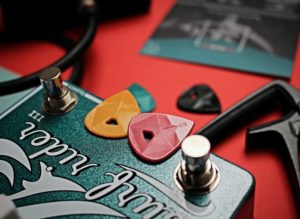
- Strings
Strings are one of those hidden costs of music that nobody talks about. Before buying strings as a gift, make sure to find out what kind of strings the person you have in mind prefers. For the best deals on strings, hit up reverb.com and you’ll find no shortage of choices. - Cables
Again, we’re looking at the mundane side of music that actually goes a long way to help make the life of a musician easier. Guitarists lose cables as often as they lose picks, so gifting a good pack of ¼ inch instrument cables will be a godsend for any musician to unwrap. Orange makes their own high quality cables that will make any guitarist’s day to receive. - Starter Guitars
You’ve talked it over with your kid and you’re 90% sure they’re committed to learning guitar. But you don’t want to go and drop a bunch of money on something they might give up in a month, or possibly even damage. Turn to the Baby Taylor BT-1. These acoustic guitars are well made and easy to play, perfect for beginners. Worst case scenario, if your kid doesn’t want to keep playing they have great resale value. For your electric-minded prospective players that want a Les Paul but you’re not willing to put down $1,500 dollars, Epiphone (which is to Gibson what Chevrolet is General Motors) makes very high quality guitars that are durable and great for beginners.
kid doesn’t want to keep playing they have great resale value. For your electric-minded prospective players that want a Les Paul but you’re not willing to put down $1,500 dollars, Epiphone (which is to Gibson what Chevrolet is General Motors) makes very high quality guitars that are durable and great for beginners. - Starter Amps
What good is a guitar if you can’t hear it? The right amp can make the life of a beginner guitarist much easier and, if chosen correctly, can last them years before they’ll need an upgrade. Take my advice, get something simple and effective. A lot of amps nowadays come with a gazillion effects that
you’ll almost never use. Marshall’s MG15R is a perfect beginner amp for any guitarist wanting to go the classic, hard rock route. The Orange Crush 20RT is also a great choice and frankly will make any beginner at least look like a professional. These amps are no joke and with 20 watts of power they’d even be good for small gigs.
- Picks
They say it’s the thought that counts, and when it comes to gear that’s true. Most musicians have to contend with some extent of self-doubt. By getting them a meaningful, useful guitar gift for the holidays, you’re supporting them both physically and emotionally and that means more than anything.
That first guitar can set them on a path in life they’ll never regret, so make it count.
Join the more than 500,000 guitarists who have experienced JamPlay. Guitar lessons from world class instructor artists in every genre and for every interest to power up your guitar skill.
Related Posts
Comments

Gear Guide: Getting the Classic Rock Sound
JP BLOG
Share this
At some point in our lives as musicians, we’ve all gone down the rabbit hole when it comes to gear. It starts with learning about pickups, string gauges, pedals and then winds up spending seven hours researching speaker sizes on the verge of tearing your hair out.
Listen. Gear is a means to an end. Gear gets us to the music. The less time spent thinking and worrying about gear, the more time you can spend thinking and worrying about music.
Let’s look over the basics of capturing the classic rock sound and explore the fundamentals of that sound and what you should look out for when buying gear to get you there.
How about a quick gear 101 to help you maximize your gear to make your music come alive?
Guitars
 We always start here on our quest for our sound, and rightly so! Besides your fingers and your amplifier, nothing else will mold your sound more than your guitar, so choose wisely.
We always start here on our quest for our sound, and rightly so! Besides your fingers and your amplifier, nothing else will mold your sound more than your guitar, so choose wisely.
If you want to sound like Jimmy Page, Jimi Hendrix, or Jeff Beck, look into what guitars they play. Get detailed with it. Find out what kind of necks they use. For instance, a long scale neck such as on a Stratocaster will give you a brighter, elastic sound. A short scale neck on the other hand, such as a Gibson Les Paul will lend you a warmer, broader sound.
Strats and Telecasters and realize they buzz or “hum” when plugged in. That’s why we have humbuckers (they “buck” the hum). What humbuckers lose in the clarity of single coils, they make up for with grit and warmth.
Amps
Amps are scary. Amps are heavy. Amps are confusing. Amps are expensive. Let me lend you some advice that applies to all significant purchases in life, not just limited to gear.
You have to do your research.
Use internet forums like reddit and scour the comments reading people’s reviews of the amps they’ve bought. Find some old players and ask them about what they use. Go into stores and play around on as many amps as you can to get an idea of what you like and what you don’t like.
For cla ssic rock, people will usually point you to Marshall, and with reason. Marshall’s been providing the sound to the best guitarists for generations. Marshall definitely has its own sound though, but if you like that sound then, why worry?
ssic rock, people will usually point you to Marshall, and with reason. Marshall’s been providing the sound to the best guitarists for generations. Marshall definitely has its own sound though, but if you like that sound then, why worry?
Orange amplifiers and Mesa/Boogie are also popular amp choices for rock. They have no problem accessing that edge of classic rock though they do tend to fall on the more expensive side.
Ready to get the classic rock sound you want? Here’s a look at how to set up your amps.
Pedals
I have a love-hate relationship with pedals. Too often they’re used as a crutch for a lack of creativity and practice. I say that because I used to abuse pedals that way. But pedals can be amazing tools in the toolkit of musicians and they are great for classic rock.
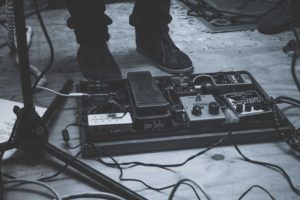 Usually what you’re going to be dealing with are a lot of boost, distortion, and overdrive pedals. Basically they’re there to make you sound loud and dirty. Mesa/Boogie makes a great line of these types of pedals as does Boss and Electro Harmonix. I would truly be doing you a disservice if I failed to mention the Ibanez TS9 Tube Screamer.
Usually what you’re going to be dealing with are a lot of boost, distortion, and overdrive pedals. Basically they’re there to make you sound loud and dirty. Mesa/Boogie makes a great line of these types of pedals as does Boss and Electro Harmonix. I would truly be doing you a disservice if I failed to mention the Ibanez TS9 Tube Screamer.
Loud and dirty my friends, loud and dirty.
Want to use effects to create the classic rock sound? Watch how.
The JamPlay Electric Essentials Toolkit includes the Maximize Your Gear Pack with 15 videos covering everything from simple guitar setup and changing strings to basic amp setup and gain stacking. Get this toolkit or others of your choice FREE with the annual membership to JamPlay.
A Question of Money
I haven’t met a musician yet who didn’t spend an inordinate amount of their income on instruments and equipment. We can’t help it, we tell ourselves. So when you’re looking at the price tags of your dream gear I want you to keep a few things mind.
- Cheap doesn’t equal bad, Expensive doesn’t equal good.
- You’re making an investment in musical real estate. Make what you buy count.
- If you feel uncertain, and you’re not on a time crunch, walk away.
Buying gear is a lot like gambling. The stakes are high, it gets your pulse up, narrows your field of vision and your sense of time. So take a deep breath, do your research, and remember: it’s a means to an end.
Once you have that new gear make sure you know how to use it right! JamPlay.com can help.
Join the more than 500,000 guitarists who have experienced JamPlay. Guitar lessons from world class instructor artists in every genre and for every interest to power up your guitar skill. Become a member today at JamPlay.com.
Photo credits in order of appearance:
Header Photo by Krys Amon on Unsplash
Photo by Giancarlo Duarte on Unsplash
Photo by José Pinto on Unsplash
Photo by Cristian Guanipa on Unsplash
Related Posts
Comments
3 Famous Guitarists You Didn’t Know Served in the Military
JP BLOG
Share this
When you think of your favorite rock and roll legends, you might think of rebels who didn’t quite fit in — misfits who marched to the beat of their own drummer. You probably don’t imagine them literally marching in unison and taking orders from drill sergeants. But the reality is, some of these famous musicians actually served in the U.S. military before, and even during, their ascent to rock hero status.
Here are 3 guitar legends who were also U.S. veterans, and the guitar styles that we’ll always remember them for:
Jimi Hendrix
Jimi Hendrix has always been a rebel, which played a pivotal role in his entrance into the military, as well as his exit.
Hendrix enlisted in the Army in 1961, the start of the Vietnam War, but only because the options were limited. After running into some trouble with law enforcement, he was given a choice: “he could either spend two years in prison or join the Army,” says Military.com.
So, that’s what he did, but the famously anti-war Hendrix wouldn’t last long. The Army could never bottle up the rebellious nature inside that made Hendrix the ground-breaking guitarist many still worship even decades after his 1970 death.
True to his nature, Hendrix would play guitar while off duty, which “didn’t endear him with the other men in the barracks,” according to Military.com. He became such a nuance to his commanding officers that they decided to discharge him. Needing an excuse, they claimed he injured his ankle, and Hendrix received an honorable discharge.
Join JamPlay to learn how to capture the truly unique and trailblazing style of one of rock music’s greatest artists. Experience how in our beginner series, In the Style of Jimi Hendrix.
Elvis Presley
The so-called “King of Rock and Roll” had a much different experience than the aforementioned Jimi Hendrix, though both weren’t given much of an option.
Presley didn’t join the Army voluntarily, instead, falling victim to the draft in 1957, when he was one of the most famous people on the planet. According to the Chicago Tribune, his fame begged the question: “Could the most famous person in the United States be useful or would he just get in the way?” But it wouldn’t take long for Presley to prove his worth. He would go on to serve in two different armor battalions and he served overseas in Germany for 18 months.
Presley’s time in the Army was a dark one though, according to the Chicago Tribune. It was a time where he lost his mother and he began his addiction to drugs, that likely ended his life. After his year and a half stint, he was discharged from active service in 1960, then from the reserves in 1964. His fans would no longer have to wait for new music from the King.
Honor Elvis as a veteran and a great musician. Join JamPlay.com to learn Elvis’s classic “Heartbreak Hotel,” which was released just a year before he started service, and others.
Johnny Cash
Shifting away from Rock and Roll to Country, Johnny Cash is the only man on our list who voluntarily enlisted in the armed forces. Cash was an interesting person, who did a lot more than make country music to be enjoyed for decades. His military experience may be the most fascinating.
He enlisted in the Air Force in 1950, during the Korean War. Cash felt lonely during his service, leading him to learn the guitar and write songs, some of which would soon become famous. Star and Stripes said Cash’s time in the military “influenced the history of rock ’n’ roll and country music” more than any other.”
Cash’s service didn’t just benefit the music community though, he also intercepted some very important information that highlighted his 3 years of service. Believe it or not, Johnny Cash decoded a morse code message from the Soviets and became the first American to learn of Joseph Stalin’s death.
Join JamPlay to gain access to learning Johnny Cash’s hits as you celebrate Veteran’s Day honoring a great veteran and legendary guitarist.
Want more? Rock legend, Jerry Garcia was also a veteran. What better way to celebrate all veterans than tapping into your inner Grateful Dead with a free lesson in the style of the Grateful Dead at JamPlay.com.
Veterans Day is a great time to learn something new on guitar and pay tribute to one of these legendary guitarists / veterans.
Happy Veterans Day!
Join the more than 500,000 guitarists who have experienced JamPlay. Guitar lessons from world class instructor artists in every genre and for every interest to power up your guitar skill. Become a member today at JamPlay.com.
Related Posts
Comments
3 Ways To Fast Track Singing While Playing
JP BLOG
Share this
After learning some basic chords, you’ve finally moved into learning some songs by your favorite artists. The problem: though you can play the music, adding the words is a challenge.
This is a common problem with beginner guitar players because playing and singing simultaneously takes a lot of coordination and rhythm that you have to take the time to learn.
Here are some tips to help you during your journey.
Start Small
Playing and singing simultaneously can start without even having a guitar in hand or committing the lyrics to memory. In fact, even just slapping your knee and humming the rhythm of the song you are learning can go miles in committing a song’s timing to muscle memory.
Two things make this exercise great. One, not having to worry about words or chords removes a lot of stress, so you can focus and gain the confidence you need to play and sing. Two, you can do this exercise anywhere: your bedroom, work, grocery store, you name it.
Then, try singing a simple melody on “bah” while you strum. Keeping the melody to just a few notes will help you get used to singing and playing at the same time.
Know Your Voice
This one may seem strange, especially because many of us aren’t the best singers. But having an understanding of your voice and its limitations will help you meld it with your guitar playing.
Try to sing along to the music you are trying to learn, and if you can find just the music. Playing and singing is hard enough without having to remember lyrics and what to do with your voice. Later, I will go over why repetition is important, but this pertains specifically to your voice. So, practice singing the song until everything about the singing process becomes second nature.
Along with an understanding of your voice, you may want to take the time to learn proper vocal techniques as well. These will not only make you sound better when you learn how to play and sing, but they will also help you with timing and other valuable things you need to know.
The JamPlay Practice Plan Toolkit includes 18 lessons on Singing, Playing, and Performing. Get a toolkit of your choice FREE with the annual membership to JamPlay.
Dissect The Song
Take these three steps:
- Listen to the song over and over again.
Whether it’s your favorite song in the world or a song you picked because it’s beginner-friendly, listening to it on repeat will help cement the song’s timing and rhythm. Make sure you are not listening to it in the background, either. You will want to examine every fascist of the song closely. - Analyze what the artist does.
Seeing is believing. Seeing the artist play and sing the song simultaneously will give you the confidence you need to do the same. Pull up a youtube video of the artist playing and singing. You could even bring up covers. Every song is different, so seeing them play may also provide you with insight into playing and singing that song specifically. This also means watching covers of the song are a great resource. - Finally, play the song until it becomes second nature.
Now that you know the song like the back of your hand, do the same with playing it. This way, you won’t have to think of what chord to play while trying to sing. You know what they say, “work smarter, not harder.”
Learning to play and sing simultaneously is one of the hardest things to master early on in your guitar playing journey, so don’t get too frustrated when struggling at first. Everyone who has learned to play guitar has been where you are now.
And if you still aren’t able to master playing and singing, head to JamPlay and sign up to become a member. The Singing, Playing, and Performing” pack is just one part of JamPlay’s Practice Plan Toolkit which contains 103 lessons and 79 jamtracks to help you improve. Get it FREE with Annual and Pro membership.
Related Posts
Comments
Signal Chain: A Look at Effects Routing (Part 1)
JP BLOG
Share this
Even if you’re just starting out, you probably own or have access to some effects pedals, a guitar amp, and/or a multi-effects unit. As your collection grows, so might your confusion. You may notice that your sound gets muddier instead of ‘cooler.’ You may buy something because you heard it on a recording you liked and then wondered why it sounds nothing like what you initially liked. You might spend more money than you need to trying to “get the sound” when you may already have all you need in an old box in your closet.
One of those things that is never really “taught” is how to place effects in your signal chain so that you’ll get the most out of them. While multi-effects generally do this for you (sometimes poorly), and offer cryptic manuals detailing how they have decided your effects will be routed, I have yet to purchase a standalone pedal that includes literature telling me where to put it in the effects chain for optimum use… and why!
In Part 1 of this series, we’re going to look at different amp configurations, their pros, and cons and talk briefly about general pedal placement. In “Part 2” we’re going to look at individual FX placement and alternative ideas to get some cool, unconventional sounds.
3 Types of Amps
Most amps on the market today deal with effects routing in one of 3 ways: serial, parallel, or input only (no effects loop). Each one of these types of situations can affect the optimal settings used on certain pedals and their placement.
Serial FX Loop
This is the most common for middle of the road amps. With this setup, there is an effects send (out) and an effects return (in). When you stick a plug in to the “send” you are completely interrupting the signal flow. The “send” would then go to your pedal(s) and then the OUT from your last pedal would go in to the “return” which returns the signal to the amp.

Some amps call the effects send a “preamp out” and the effects return a “power amp in.” These terms are interchangeable for the most part but suggest some interesting possibilities.
Let’s say you have a combo amp with a serial FX loop. It’s a low wattage amp and you need more power. You can go out of the FX send (preamp out) and go in to a more powerful power amp… say the FX return (power amp in) of large tube amp. Remember that there will be no sound coming out of your combo amp because your effects send completely interrupts the signal, but you might get some cool sounds mixing preamps and power amps from different amps. If you experiment with this, be sure to consult your owner’s manuals and take note of any minimum load requirements for speaker outs if you are using a standalone amp head.
Most modeling boxes such as the Line 6 Pod line, Digitech RP series, Boss GTx stuff sound and feel better (when using all of their modeling technology) going directly in to the effects return of an amp rather than going in to the guitar amp’s “input.” This is because the pedal board/modeling box already has a preamp built in to it. Sometimes, when you plug a preamp in to another preamp, there is a muddiness or dulling of the sound that occurs. If you do this, make sure the speaker emulation on the FX box is turned off and you’ll be good to go. It also works best if your amp has a master volume control. If there is no master volume, you have no way of controlling your volume except on your FX unit output.
Parallel FX Loop
This type of loop allows your amp signal to pass ‘untouched’ from the guitar through the amp to the speaker and then simultaneously add the FX signal to the original tone rather than giving that responsibility to each individual pedal. Here’s how this looks:

This setup does have its drawbacks. Certain effects such as tremolos don’t function well in this environment because they need control over the whole signal to generate their desired effect. For example, if you want that “ON/OFF” square pulsing effect out of your tremolo, you can’t add that to a dry, raw amp signal or you won’t ever have any “OFF.” You’ll have amp sound, PLUS the tremolo ON/OFF which will lead to a “more or less” effect… not what you intended. Jet flangers, harmonizers, rotary speaker simulations and certain other chorus effects are among those that also don’t do too well with parallel setups. Delays, reverbs and subtle chorus and flange effects really shine with parallel FX loops.
Input Only (No Loop)
Unfortunately, some amps don’t include FX loops. This is really a bummer because it really limits the types of sounds you can get with your amp and still use effects. You can still do it, but you have to be careful. Effects such as delay, chorus and reverb don’t do so well if they are placed before distortion and overdrive, so if you want to use your amps distortion, but don’t have a loop, you’re pretty much out of luck.
Basic Effect Placement Guidelines
As stated earlier, we’ll be going over exceptions and alternatives in Part 2, but there are basic guidelines and little tidbits that should be common knowledge before getting in to the deeper stuff. The simplest way to look at effects routing and order is to categorize it as either a “pre drive” or “post drive” effect. A pre drive effect is placed before any distortion or overdrive in the signal chain. These would be placed between the guitar and the amp input using an amp with an FX loop or between the guitar and the first overdrive/distortion pedal using an amp with no loop. Tthe amp without a loop needs to be pretty clean sounding, not overdriven, to avoid FX blurring and muddiness. Below is a good place to get started when placing your effects in order for a good, clean, workable sound. Get your effects arranged using this guide, and we’ll look at intentionally messing this up in the next lesson:
Guitar —> Tuner/Mute —> Volume Pedal —> Wah —> Whammy —>Clean Boost/EQ —> Compressor —> Overdrive —> Distortion (**Or using drive on amp. All effects after distortion are considered “Post Drive” effects) So… either in the FX loop or in front of a clean amp AFTER overdrives and distortions: Harmonizer —> Chorus/Flange/Rotary/Vibe —> Tremolo —> Gate/Noise Reduction —> Delay —> Reverb.
If you’ll notice, the pre drive effects are placed from ‘most mild,’ or the least signal altering effect (mute and volume controls), to the most ‘extreme.’ This is a good rule of thumb when placing your pre drive effects. Also, notice that all of the pre drive effects (with the exception of the whammy which could be considered part of the ‘harmonizer family’ really works well as a pre or post drive effect) are dynamics altering effects. In other words, they alter the original signal by adding gain, adjusting the volume or a specific frequency area of the guitar signal. They don’t add to the signal. Modulation effects such as chorus, flange, reverbs and delays are clearly adding a pitch or time-based element to an existing tone. This distinction, for the most part is what helps classify an effect as a pre or post drive effect. The general guideline is:
Dynamics-based effects should be placed BEFORE the drive circuit (whether a pedal or the distortion on the amp) and time/pitch-based effects should be placed AFTER the drive circuit.
If you read the manuals for most multi-effects units, they explain their signal chain pretty clearly and you may not even have to worry about these basic routing rules when trying to get sounds initially, but many boxes allow you to change around your routing. They also provide what’s called a semi-parallel option. This means that your pre drive effects are all run in series (one after the other in an order similar to what is suggested above) but then the signal is sent to a number of post drive effects at the same time and then combined before going to the output. This might look something like this:

This is actually quite a cool way to do things and is difficult to do with individual pedals. One of the advantages here is that you can feed the same signal to two different delay effects at the same time — eliminating the traditional “first delay messes up the second delay problem.” You can also get a cleaner delay/reverb distinction if one is not being fed into another. This is where multi-effects units really shine!
So, dig out your pedals and effects and start seeing what you can come up with. Stay tuned for some other ideas and techniques in Part 2!
Authored by: By Chris Liepe
Related Posts
Comments
4 Pitfalls to Avoid When Learning Guitar
JP BLOG
Share this
Learning how to play the guitar is a blast! Everything is a mystery and every day is a new revelation!
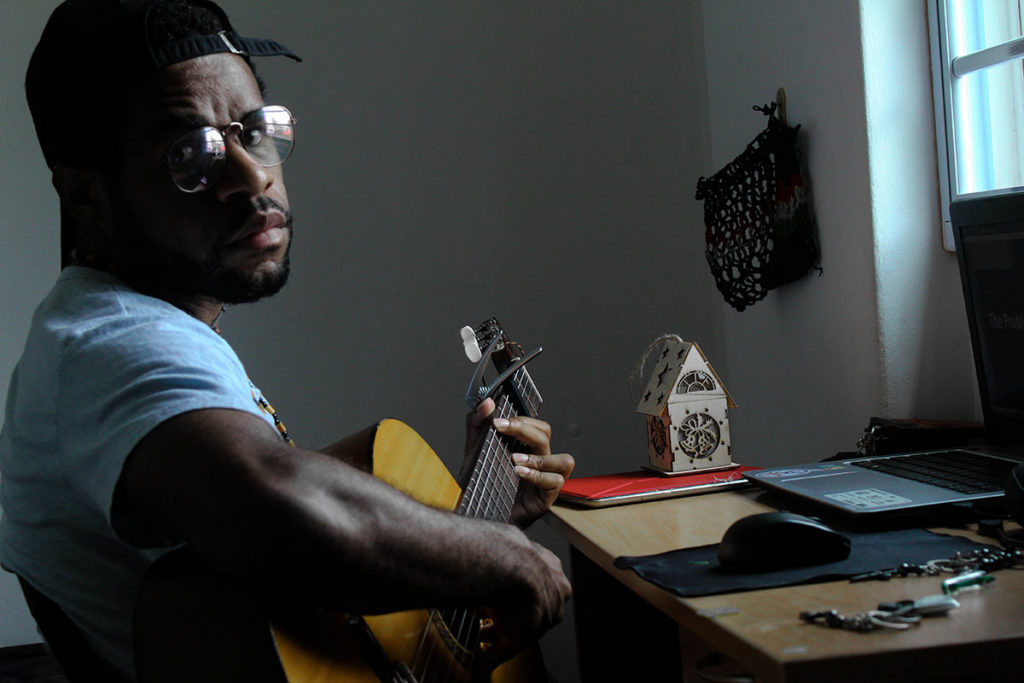
But learning and practicing guitar can also be frustrating. We need to understand that frustration is not something external, we create it ourselves. If we can create it, then we can surely beat it too. You can call it lack of patience or in some cases lack of dedication. As guitar players, we find ourselves stuck, some days it feels good while on other days it just doesn’t. Most beginners love their weekend practice sessions, until they realize after a few weeks that they are not making any progress, that they lack focus and decide to call it quits.
It’s because they forget their last lessons easily and the techniques learned never become second nature which leads to boredom and frustration. Some of them call it quits while others continue to follow the pattern.
Here are 4 frustrating pitfalls that you should avoid:
- Don’t try to be a jack of all trades, master of none. Trying to learn too many things will psychologically mess you up. Instead, make sure you fully learn something before moving on. The thing you are learning (barre chords, scales, licks) should be second nature.
- Don’t learn from guitar teachers or players that are only interested in showing off their skills. Guitar is not a competition. And these people will make you feel like it is. Which will make you feel bad about your playing and start the cycle all over again.
- Don’t continue with the weekend sessions. Most beginners start that way and it is just not good enough. You must practice daily. No excuses. Otherwise you will lose interest, forget what you learned prior to last week, skip a session or two and all this will lead to inconsistency. Being inconsistent will lead to frustration. Fight it with passion. Don’t let that fire die down.
- Stop comparing yourselves to others, especially your chosen idol. People like to talk about their skills and this can demotivate you or worse, frustrate you. Understand that everybody has to start somewhere, each one of us has a different learning speed, not all are made equal and you are not Slash! So take it easy on yourself and don’t forget to enjoy the journey.
What you should do instead:
 Playing and practicing are not the same. You may think you’re putting in a lot of hours on the guitar. But the real question is – are you really practicing or are you just playing? You might know what I am talking about here. Playing guitar is just that – you play your guitar without learning new techniques or developing new skills. You just kind of refresh your old licks and songs. Practicing on the other hand is when you learn something new, refine or rediscover something old; find a new meaning out of a long forgotten lick or perfecting that trick you picked up some time back. The idea is to keep moving forward.
Playing and practicing are not the same. You may think you’re putting in a lot of hours on the guitar. But the real question is – are you really practicing or are you just playing? You might know what I am talking about here. Playing guitar is just that – you play your guitar without learning new techniques or developing new skills. You just kind of refresh your old licks and songs. Practicing on the other hand is when you learn something new, refine or rediscover something old; find a new meaning out of a long forgotten lick or perfecting that trick you picked up some time back. The idea is to keep moving forward.
(Quick Tip For Beginners: Your fingers are going to hurt and hurt like hell. But this is ok. This is normal. After sometime the skin will toughen up and your hands will get used to the pain. This is also called muscle memory. The human body is incredible!)
What is important is to remember why you are here. Is it because you eat, drink, and sleep music? Are you learning guitar to impress other people or are you learning to just get better? Don’t lose sight of your goals. Always have a plan. This will help you fight frustration like nothing else. It will motivate you to work not only harder but also smarter. And working smarter is the key to progressing faster on guitar!
Related Posts
Comments
These Might Just Be The Best 10 Tips For Guitar Players Ever
JP BLOG
Share this
In my capacity as a guitar teacher I hear lots of excuses, including the time-worn “I don’t have the talent.” Talent, schmalent. While we can’t all be Hendrix, you can get pretty damn close if you follow these basic guidelines:
1. Learn the notes on the fretboard
There’s a lot of them but you don’t have to memorize them all at once. Start with the open strings – EADGBE (top to bottom) — and use a mnemonic trick. I like “Eddie and Dave Got Bad Eggs.” If you go from bottom to top, try “Every Bad Girl Deserves an Eggplant.” Once you’ve got that, move on to the first four frets on each string. Play each string slowly and say each note out loud, from the top (bass) string to the bottom. After those are memorized, you can move to the next four frets. This chart will help:
Why learn the notes? For a myriad of reasons, Grasshopper.
- You can communicate better with other musicians.
- You’ll understand theory better.
- Most importantly, you’ll play in tune.
If you’re playing an F note in your solo and the song is in the key of G, your audience’s ears will bleed. If you know the names of the notes, you’ll know where that pesky F lives so you can avoid it and save the hearing of millions of people.
2. Learn the sound of chord types
Start with the difference between a major and a minor chord. You can hear the difference between an A minor and an A, right? Without diving into too much theory, I’ll tell you that a minor chord has a flatted third. That’s what gives it that dark sound, perfect for a change in mood. Other chords have their own associations. A seventh chord has a blues feel. They also sound great at the end of a phrase, especially if you go to a major chord after that. Ninth chords are perfect in jazz and sometimes as a transition in other styles.
Experiment.
If you usually play a minor chord in a song, what happens when you substitute a major? Ninth? Becoming familiar with different chord types will help you figure out the chords to a favorite song. It’s also a great tool for songwriters.
3. Listen to a variety of styles for inspiration
Okay, you’re a metal head. Did you know that Randy Rhoads (Ozzy Osbourne) studied classical music? Maybe you’re into classic rock – did you know that in the early days the Beatles were a skiffle band, a form of folk music? That’s where that picking pattern in “Blackbird” comes from. So, raid your little sister’s music collection and play along to that Shawn Mendes tune. You don’t have to love it and I’ll bet you’ll learn something. Or see what your girlfriend’s Bob Marley mix has to offer you. What happens when you play a reggae strum for a pop song?
Magic, that’s what.
4. Learn how to hum and play simple melodies
Ignore the advice you got for grade school choir. Ear training is possible for even the most tuneless singer. Start by playing one note and singing it. Once that sounds pretty good – and it may take a few tries — try for two notes, then for more. Record yourself and see how you’re doing. Have someone with a good ear listen to you. Once you’re better at singing a melody you’ll be able to look at that challenging section of a guitar solo. Hum it slowly and match the notes on the guitar. It can also help you compose an original lead part or figure out what chords go behind a melody. I once worked with a record producer who sang the bass player his notes (albeit in a different octave); we ended up with great arrangements. Keep in mind that being able to sing doesn’t mean you have to be your band’s lead singer, it’s simply a tool.
5. Play music and not just scale exercises
If you’re a soccer player, you don’t want to spend hours kicking the ball into the net. Yawn. Same thing for guitar. Find a song you really want to learn and even if you can’t yet play all the riffs, slow it down and figure it out. Or learn from one of the great teachers at JamPlay. Or, if you’re a songwriter, write a song you can hear in your head but can’t quite play. It’s one of the ways I became a better guitar player — I kept writing songs I couldn’t play. Scales are still good but learning within the context of a song will make you remember why you picked up the guitar in the first place.
6. Learn to play slowly and in time
If I had a nickel for every time a student came to me and played too fast and with lots of mistakes, I could retire to a villa in the South of France and fly in Bonnie Raitt for private lessons. When you play too fast, you’ll make mistakes. Guaranteed. And muscle memory is a pesky thing — your fingers will play those mistakes over and over again. Play the piece slowly and correctly. Play it with a metronome on snail speed. Once you’ve mastered that, kick it up a couple of notches. Play it again. Keep playing it at increasing speed until the mistakes start to creep in, then stop. The next time you practice, do it again, starting at something slightly above the snail setting. While I’m yammering on about rhythm, I’ll tell you that it’s important to play with a metronome. No one wants to hear a guitarist who speeds up and slows down. Your fans will love you and your band’s drummer will quit throwing her sticks at you.
7. Learn songs in different keys
I once wrote a country song in the key of F, unusual for that genre (unless you’re playing with a capo). While I hated myself for the first few weeks, I got really good at a barred B flat. Expanding your chord knowledge will make you a better player. No one wants to jam with a guitarist who can only play in C.
8. Don’t compare yourself to others
Everyone’s seen that video of the little Korean kids playing the complicated classical piece. Don’t look at that and throw up your hands. You don’t know what torment those kids endured. And likewise, don’t watch a great Jeff Beck solo and think, Why even try? Maybe you should start on something more accessible. There are lots of JamPlay videos that can help you with that. At some point, maybe you can tackle that Beck solo and if you don’t, the world won’t end. Pardon me while I give the special snowflake speech but you are unique. No one plays exactly like you.
9. Record your practice sessions and listen back to them
What we hear in our head is not always what actually comes out. If you’ve ever been in a recording studio, you’ll know what I’m talking about. I once recorded with a guitar player who was a half beat behind everyone else and we didn’t notice it until it was time to mix. Expensive mistake. If you record your practice sessions, especially if you can do it with a metronome, you can better evaluate your timing. It’ll also help you remember that improvised solo that was so good in the moment. And you can mark your progress. Listen to that recording from six months ago and pat yourself on the back because you finally mastered those Stevie Ray Vaughan licks.
10. Learn something new every day
If you’ve been playing the Beatles for thirty years, it’s time to branch out, even if it’s learning one new chord. Are you mostly a country player? Look up ninth chords. They’re fun and who knows, they might sound good in that Dolly Parton song you just learned. Are you a rocker who can’t fingerpick? Learn one fingerpicking pattern. Just one. Practice it every day and soon, you’ll be playing “Blackbird.” And yeah, I’m back to the Beatles but maybe it’s time to try that new distortion pedal — what would “Blackbird” sound like with that? All right, Hendrix Junior, follow these tips and quick coming to me and whining about talent. With enough sweat and stellar attitude, you’ll master whatever you want on the guitar.
Related Posts
Comments
Barre Chords Unlock 1000s of Songs on Guitar
JP BLOG
Share this
Quick! Play a G sharp chord. I’ll wait …
It’s easy to come up with a G chord but sharp chords can be more elusive unless you know barre chords.
 Before you run screaming from the room, stay with me.
Before you run screaming from the room, stay with me.
Barre chords are gifts from the gods and they can really benefit your playing. And it’s like anything else with guitar – start slowly, practice, and keep an open mind.
I’m a 58 year old woman with arthritis and I can play a barre chord. Not to shame anyone but if I can do it, so can you.
Follow this list and I guarantee before long you’ll be making barre chords like a rock star.
1. Pick out a song you already know that has a G chord
(we’ll deal with that sharp chord later). You probably already know this G chord – it’s an open chord:

Now we’ll move on to a G barre chord. Here’s the shape. You’ll notice it looks like an E chord only you’re using your index finger like a capo. Put this shape on the third fret:

2. At first, the barre chord will sound like crap.
Be okay with crap. Be one with the crap because eventually, your hand will become stronger and more flexible and that chord will sound clear.
3. Now play that song with the G.
Every time that chord rolls around, play the barre chord. It may take you a few seconds to get the shape, just breathe and do it. It’s not super hero time – you don’t have to play the entire song with barre chords, just the G.
4. It may be uncomfortable but it shouldn’t hurt.
If it does hurt, stop and play something else for a while, then go back to it. If it still hurts, go pet the dog, read your email, and try again. Breaks are good, especially when you’re asking your hands to do something they’ve never done.
5. Practice. Rinse and repeat.
6. Now to that G sharp – use the same shape and move it to the fourth fret.
Voila! G sharp. It works for lots of other chords, too.
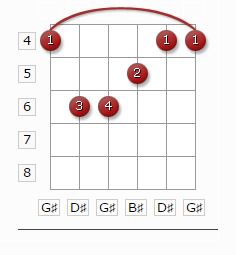
7. You can also do cool muting and other rhythm tricks with barre chords.
Jim Deeming explains how to play barre chords with very little finger pressure in this video:
These chord shapes unlock thousands of songs on guitar because you can play 120 chords with just 10 shapes.
Now go to it, rock star.



